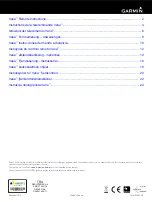
2
Chapter 1: Introduction and General Information
1-3 HELMET COMPONENTS
The helmet includes the following components, shown in
:
Helmet Shell.
The helmet shell is intended to provide head protection during in-flight buffeting and
emergencies such as ejection, bailout, or crash landings. It has a fitted leather
edgeroll.
Leather
buffers
prevent the visor from scratching the helmet shell.
Pile fastener
inside the shell holds the
earcups in place. Portions of the pile fastener are left detached to allow installation of the oxygen
mask bayonet receivers.
Energy-Absorbing Liner.
The rigid polystyrene energy-absorbing liner absorbs and reduces
impact forces. The liner is held snugly to the inside of the helmet shell by the edgeroll.
XLiner® or Thermoplastic Liner (TPL®).
The helmet comes with a choice of the XLiner or
the TPL. The
XLiner
provides a close fit, improved comfort, ease of adjustment, and simplified
installation. It is constructed of anti-microbial, anti-static fabric that also reduces heat buildup inside
the helmet. The preformed
TPL
consists of a thermoplastic
layer assembly
(which can be heated
and custom-fitted if necessary) and a removable, washable, ventilated
cloth cover
. (An optional
Super Comfort Liner, or
SCL
™, is also available; see Page 56 for details.)
Integrated Chin/Nape Assembly.
The integrated chin/nape assembly, when properly adjusted,
stabilizes the helmet during routine flight, bailout, and other high-stress conditions. Tightening the
chin strap
also tightens the fit of the
nape pad
. Metal
clamps
help keep the adjusted chin strap
in place.
Headset.
The headset allows the aircrew member to communicate both inside and outside the
aircraft. It also helps protect the ears from hearing loss due to long-term exposure to noise.
Included are two
earcups
(for lateral impact protection and sound attenuation), two 19-ohm H-143/
AIC
earphones
, and a CX-4708A/AIC
cable
. The earphones are housed inside the earcups and
are connected to the cable. A
jack holder
fastens the cable to the outside of the helmet.
Visors.
Each helmet includes two snap-on visors (one clear and one sunshade) and a visor cover.
Helmet-visor configurations are as follows:
•
HGU-55/P helmet with
MBU-12/P visors
:
81D5330-
7
(Medium)
, 81D5330-
8
(Large)
, or 81D5330-
9
(X-Large)
•
HGU-55/P helmet with
high-speed visors
:
81D5330-
13 (Medium)
, 81D5330-
14 (Large)
, or 81D5330-
15
(X-Large)
•
HGU-55/P helmet with MBU-20/P visors:
81D5330-
16
(Medium)
, 81D5330-
17
(Large)
, or 81D5330-
18
(X-Large)
Bayonet Receiver Kits.
For attachment of the oxygen mask, there are two types of bayonet
receiver kits. The
standard bayonet receiver kit
is provided with all helmets. The
anti-snag
receiver spacer kit
is provided with helmet part numbers 81D5330-
13
, 81D5330-
14
, and
81D5330-
15
and includes components to prevent snagging on the bayonet receivers; it is used
with the bayonet receivers and backing plates from the standard bayonet receiver kit. Both types of
kits include all attaching hardware. The receivers are custom-fitted to each aircrew member.
(Other types of bayonet receivers are also available; see Page 59 for details.)









































